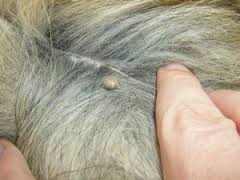Tick Alert: Pet Owners Beware
by Nomi Berger
With the arrival of summer comes the arrival of an annoying and possibly fatal pest: the tick.
What was once considered a nuisance found only in the wooded countryside has been persistently and increasingly invading cities both large and small. Now ticks can be as close as your neighbourhood park or your neighbour’s backyard.
What, precisely, is a tick? A tick is a fairly common, external parasite that embeds itself in the skin of both animals and humans. Once it lands, it inserts its mouthparts into the skin and feeds on the blood. And that single tick has the potential to pass on multiple diseases.
Deer ticks and Western Blacklegged ticks can carry Lyme disease and Rocky Mountain spotted fever, which animals (and humans) can contract.
Prevention and early detection are the best ways of protecting your pets against Lyme disease. The intent is to stop it before any symptoms appear. Should the disease progress, symptoms can include stiff, painful and swollen joints, and a limp that comes and goes, often appearing to switch sides. Some dogs have an arched back and a stiff walk. More serious, however, are fever, difficulty breathing and kidney failure. Heart and neurological problems are rarer.
To help protect your pet, there are several preventatives available – such as K9 Advantix – which stops ticks BEFORE they bite, killing, not only all of the major tick species, but acting as a flea treatment as well. A product meant only for dogs, K9 Advantix must NOT be applied to cats.
Such preventatives are particularly important for high-risk animals such as hunting dogs, cottage dogs, and dogs hiking through fields. But it’s important to remember that dogs (and cats) can pick up ticks in the city as well.
When bitten, the skin of some pets may become red and irritated around the site, while others may not even notice the parasite attached to them. It is imperative then, that you inspect your pet thoroughly when returning from areas known for ticks.
Should you find a tick on your pet, it must be removed very carefully to ensure that the mouthparts are fully removed. If left behind, they can abscess and cause infection. Kill the tick by placing it in a zip-lock bag and pouring rubbing alcohol over it. For the uncertain owner, special tick removal devices are available, while the squeamish can have their vet remove the tick instead.
Some experts now advise that when your pet is tested annually for heartworm, the same test include screening for Lyme disease, ehrlichiosis and anaplasmosis (both bacterial infections). A positive test result enables you to start treating your pet early — before the onset of any symptoms.
Never was the expression “an ounce of prevention is worth a pound of cure” more true.

